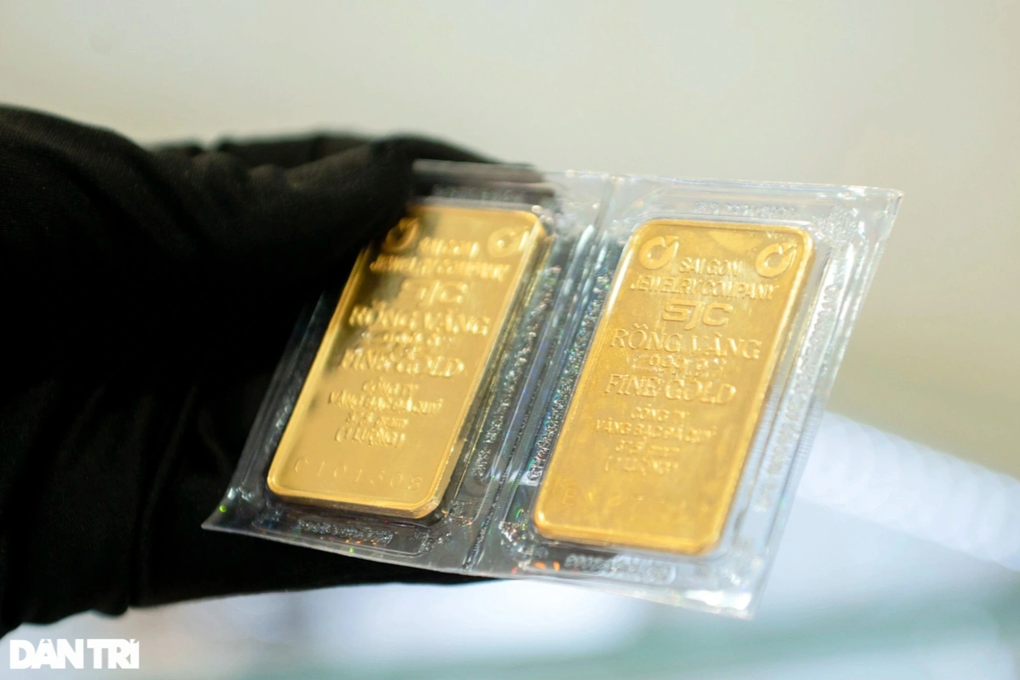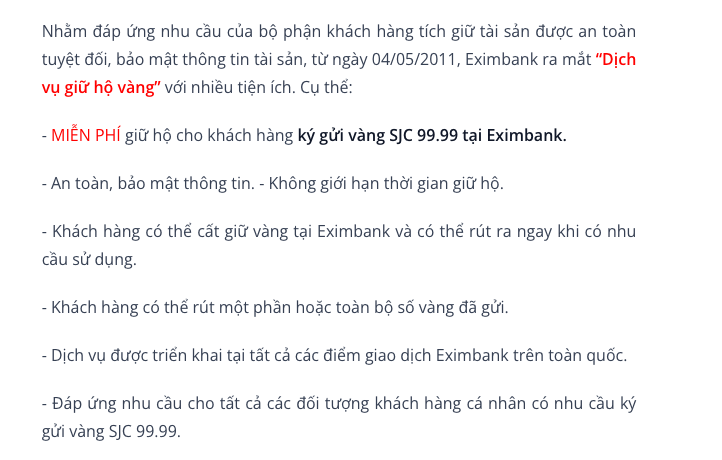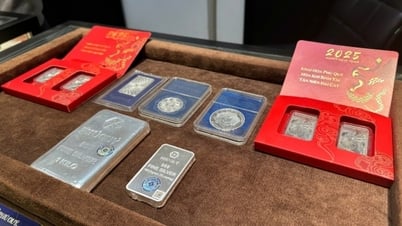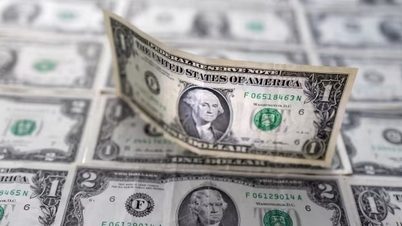Before 2012, in Vietnam, gold savings and gold mortgage loans were very popular financial activities at commercial banks.
Gold mortgage loans and gold savings deposits were once popular but were later tightened.
With gold savings, at that time, people brought physical gold to the bank to deposit and were given a savings book stating the amount of gold deposited, term, interest rate, etc. The interest rate at that time was even paid in gold or converted into money, depending on the bank and regulations at that time.
At many bank transaction points, passersby can easily recognize gold mortgage signs with interest rates. The reason these activities attract people’s money is because of their preference for gold, considering gold a safe place to store assets. In addition, there is concern about risks that may occur when keeping gold at home such as theft, fire, etc. Meanwhile, depositing gold at the bank both retains its value and earns interest.
From the banks' side, these units can take advantage of the mobilized gold source to lend gold (especially to businesses that need capital in gold) or sell gold to have more capital for business purposes.
However, this also puts banks at risk of gold price fluctuations, term mismatch risks (short-term deposits, long-term loans), and gold liquidity risks (gold repayment due without enough physical gold to repay).
Gold-backed lending was also popular during the period of sharp gold price increases in 2009-2011. At that time, people or businesses could bring gold to the bank to mortgage (pledge) to borrow cash. The bank would keep the physical gold in storage and return it when the borrower paid off the loan. People then did not need to sell the gold but still had money to use. Not to mention, if the gold price increased, the gold would still generate profit even if it “stayed in one place”.
However, this leads to limitations for banks because if the gold price fluctuates strongly, there is a risk that the collateral is not enough. In addition, there is a risk of gold liquidity if depositors withdraw simultaneously and the pressure of managing physical gold when it is necessary to have a safe storage facility, security personnel, inventory, etc.
Not to mention, according to experts, this can create an imbalance in banks mobilizing short-term gold but lending long-term. Some banks use mobilized gold to sell for money, and when people withdraw gold, there is not enough physical gold to return, leading to the risk of a system collapse. This also puts pressure on the foreign exchange market because foreign exchange must be used to import gold.

Saving gold or using gold as collateral for loans used to be a popular activity (Illustration: Thanh Dong).
Faced with the risk of instability in the gold and currency markets, the State Bank issued Circular 11/2011 and then Circular 12/2012, requiring banks to stop mobilizing and lending capital in gold from June 30, 2012. Banks must also transfer all gold mobilization balances to the form of gold custody without interest.
A series of official dispatches requesting credit institutions to strictly control lending activities secured (pledged, mortgaged) by gold were issued at that time.
The monetary regulator also requires commercial banks to closely monitor the use of loans by customers. At the same time, credit institutions must also commit to taking responsibility before the State Bank if they lend capital to organizations and individuals for gold speculation, causing disruption to the gold and foreign exchange markets.
The gold management agency also requested the inspection and supervision of banks and the State Bank branches in provinces and cities to closely monitor the lending activities of gold mortgages and gold pledges by credit institutions; plan to conduct inspections, handle violations and report.
Current time: Banks are keeping gold
To date, banks no longer mobilize gold or lend gold. Gold is only used as collateral in some special and uncommon cases (non-bank credit institutions or financial companies, pawnshops).
The State Bank strictly controls gold-related activities to stabilize the financial market, and only licensed entities are allowed to trade in gold. Currently, the country has 22 banks and 16 businesses licensed to trade in gold bars.
In particular, four state-owned commercial banks, including Agribank , BIDV, VietinBank, and Vietcombank, are allowed to sell “price-stabilized” gold from June 2024. The banks only sell, not buy, and the gold price is decided by the State Bank. In particular, customers who want to buy gold must order online and wait for notification to receive the goods.
Banks are still allowed to open gold custody services with fees. According to a survey by reporters, TPBank and Eximbank are the units that publicly offer gold custody services with detailed regulations on gold deposits and withdrawals.

Gold keeping service at Eximbank (Screenshot).
At other banks, gold custody services are not popular, instead, asset preservation services are used. Customers can still deposit gold with this service and comply with the conditions of each bank.
Will gold trading floors facilitate people?
On May 30, the State Bank announced the results of its inspection of six major gold trading units in the market, including two banks: Tien Phong Commercial Joint Stock Bank (TPBank) and Vietnam Export Import Commercial Joint Stock Bank (Eximbank).
Banks are basically assessed by the State Bank to comply with regulations on gold trading activities, reporting data, and have more positive changes in anti-money laundering... However, these units still have violations, such as employees facilitating "fake" gold bar transactions; regulations on anti-money laundering; invoices, accounting documents, taxes; incomplete reports of suspicious transactions; receiving gold for safekeeping without sealing, without recording the series...
Associate Professor Dr. Nguyen Huu Huan, lecturer at the Ho Chi Minh City University of Economics , said that the recent inspection of the gold market could help limit speculation and hoarding activities, but this was only a temporary solution and could not solve the problem at its root. In the long term, synchronous solutions are needed, the most important of which is to break the monopoly and establish a national gold trading floor, as directed by the General Secretary.
Currently, the gold trading activities of commercial banks are no longer as vibrant as before. Among the banks licensed to trade in gold bars, only a few units such as TPBank and Eximbank are still actively operating. Some remaining banks, although licensed, seem to be less interested in this field, instead focusing on foreign currency trading.

Gold keeping service at TPBank (Screenshot).
Mr. Huan emphasized that in order for the gold market to operate stably and transparently, it is necessary to move towards establishing a national gold trading floor managed by the State Bank. This solution will be the foundation to overcome the large gap between domestic and world gold prices, and at the same time help implement monetary policy effectively.
According to him, the gold trading floor will create favorable conditions for people to deposit or trade gold, thereby helping to attract the amount of gold being stored by people into the economy. This will help reduce the pressure on importing physical gold, reduce the demand for foreign currency and limit the negative impact on foreign exchange reserves.
He also proposed a gold trading floor model that combines both real and account trading. This model not only helps increase liquidity but also meets the investment needs of people, especially new investors. When the demand for holding physical gold decreases, the market will be less pressured and operate more stably.
To operate effectively, gold exchanges need to invest in modern technology systems, applying solutions such as blockchain to ensure safety, security and transparency. At the same time, there needs to be a clear legal framework and close supervision by management agencies to avoid repeating mistakes like the period of spontaneous gold exchanges before 2012.

Experts say there is a need for a gold trading floor (Illustration: Manh Quan).
In addition, the establishment of a gold exchange will help narrow the gap between the buying and selling prices of domestic gold, which is currently very high, at around VND2 to VND3 million per tael. He compared that on the stock market, the gap between buying and selling prices is usually only 0.3-0.4%, mainly due to transaction fees and taxes. If the national gold exchange comes into operation, the gap in gold trading prices will also be narrowed, contributing to connecting the domestic market with the world.
Economist Le Xuan Nghia, member of the National Monetary and Financial Policy Advisory Council, also said that it is necessary to conduct early research and learn from the experience of building gold trading floors in other countries, including China.
He pointed out that China has two gold exchanges, including the physical gold exchange and the gold certificate exchange. However, the physical gold exchange is the most active. China has licensed five state-owned commercial banks, four foreign banks and four largest gold and silver trading companies to import from abroad and sell wholesale on the exchange.
He said that Vietnam's gold trading floor should also sell physical gold wholesale to gold businesses, then the businesses will retail to the public. "When there is a floor, there will be a unified price, openness, transparency, and there will be no abuse of monopoly to speculate and manipulate the market," he said.
Source: https://dantri.com.vn/kinh-doanh/cac-ngan-hang-dang-lam-gi-voi-vang-20250604002103568.htm
































































































Comment (0)